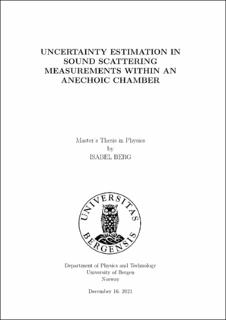| dc.description.abstract | Uncertainty was estimated for seven variable changes in sound scattering measurements in an anechoic chamber to explore their impact individually and compared to each other. These variables were change of loudspeaker, switching the ventilation system on/off, repositioning the microphone, repositioning the loudspeaker, deviation in velocity of sound, deviation in angle of normal incidence, and deviation in dimensions for the scattering object. This was studied for a cylinder and a box object. For four of the variables the uncertainty was estimated by use of repeated measurements, using post-processing to find the directivity index of the microphone as mounted in the scattering object. Simulations were used to study the latter three, utilizing the analytic solution for an ideal infinitely long, rigid cylinder, while the box was modeled with a numerical solution toolbox which uses the edge source integral equation (ESIE) method. For the cylinder object, a change in loudspeaker led to a change in directivity index limited to 0.6 dB for most of the ka values. For the variables that were simulated, the difference in directivity index was within a range of ± 3 × 10^(-3) dB, with a deviation in the velocity of sound contributing most at lower frequencies, while a deviation in the radius of the cylinder gives the largest difference from ka values 10 and above. For the box object, four variable changes were compared through measurements, where the difference in directivity index stayed within a range of 0.5 dB for most frequencies. A change in loudspeaker gives the largest difference for lower frequencies, while for kl values 20 and above, repositioning the microphone and the scattering object gives the largest difference in directivity index. For the simulated variables, the difference in directivity index was found to be less than approximately ± 0.04 dB; up to kl number 50 the largest contributor is a deviation in the box dimensions, while higher kl numbers saw deviation in the angle of normal incidence having the largest impact. The contribution to the uncertainty for scattering measurements in the anechoic chamber were not all as expected, and for users of anechoic chambers it may be prudent to examine these magnitudes to make sure that the precision is not portrayed as better than what is realistic due to unknown uncertainties. | |
